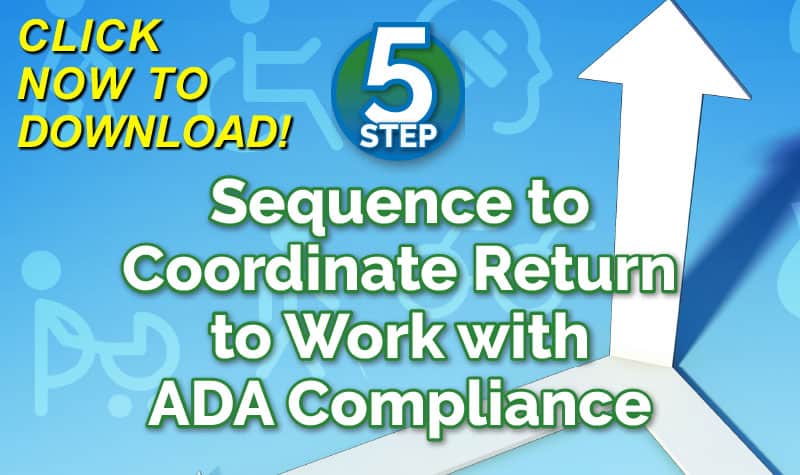
By integrating leave programs, employers can see significant cost savings, fewer days away from work and improved productivity. But going from a mixture of rules and regulations to a single, streamlined system can be daunting, especially for smaller organizations.
The Challenges
There are a variety of federal, state and municipal programs. The Family Medical Leave Act, Americans with Disabilities Act, short- and long-term disability, and workers’ compensation are just some of them, along with state, county and municipal leave laws and employer-specific leaves. Some may overlap. Some involve payments, while others do not. And they change frequently — through amendments or the implementation of new leave laws. Keeping up to date with them all and ensuring you administer them properly is a challenge for even the largest employers.
There are likely multiple contact points, depending on the type of leave involved. Each leave involves forms that must be filled out and, sometimes, require payments. If outside vendors are used, inaccurate information sharing may result in payments being too little or too much. Employees may receive information from multiple vendors, causing confusion and frustration. Finally, it’s nearly impossible for an organization to analyze the data and understand the impact of absences — unless the systems are integrated.
Getting a streamlined, integrated system involves collaboration, more than anything. Where there are silos within a company, those within them must be willing to work with one another and share information. At the least, HR, legal, benefits and risk departments must cooperate.
Leave Integration Programs
Integrating occupational and non-occupational leave programs can take a variety of forms, from the simple to the highly sophisticated. The more advanced models include wellness, disease management and even employee assistance programs.
Whatever type of program is implemented, integrating leaves generally results in overall lower costs and possibly better outcomes. You can start the process by taking stock of what’s already in place at your company.
- Look at your data. Starting an integrated leave program should begin with an assessment of the amount and cost of absences taken annually by employees. Employers who do so typically find their employees are taking off more time than they realized, pointing to the need to take action.
- Talk to your partners. Third party administrators and insurers, along with any vendors you use should be willing to provide data and other information that sheds light on the management of your leave programs; as well as what they do for other employers..
- Read the handbook. Take a close look at the policies and procedures already in place for various leaves. You may find some that duplicate or contradict one another.
- Bring in the troops. Departments that have any responsibility for absence programs should be included in discussions right from the start of the integration process. You might find ways to automate some of the existing processes.
Building the Program
Once you’ve seen a picture of your company’s leave programs and looked at the data, there are several key factors that can help make for an effective IDM program.
1) Single Claim Intake Source.
This will reduce administrative costs and make it an easier, more pleasant experience for employees. Having one phone number is a great way to ensure all leave requests are captured in a single source. This could also allow for a single provider to contact the worker if their leaves constitute more than one, such as short-term disability and FMLA.
2) Communication
Any and all changes to leave policies should be shared with managers, supervisors and employees. It’s imperative that everyone has the most up to date information.
3) Collaboration
As explained above, integrating your absence management programs should involve personnel from several different departments who must work together. Workers’ compensation, group heath, disability insurers, legal counsel, and any other organizations that manage employee health should discuss how they can combine their data and resources. During such meetings, goals should be set and roles and responsibilities should be discussed and agreed upon.
4) Data Sharing / Tracking.
Employers can look at trends for such things as frequency, duration, cause, occupation and business unit to determine if and where changes could be made to reduce costs and improve productivity.
5) Updates
Changes in laws that affect any of your leave programs should be brought to the attention of all involved. The team can assess the changes and determine how to proceed. There should be a process established to update leave programs depending on changing needs of your company. In addition to tracking legal and internal changes are technological advancements that should be considered. For example, having an app for employees to report absences might be useful.
6) Uniformity.
It is crucial that leave policies be administrated consistently and clearly.
7) Evaluating The Program.
Depending on how the program is handled, you want to be able to see the effectiveness. It may involve a software system or outsourced organization. Ideally, you should be able to identify lost time, costs and return-to-work rates, and see what if any changes should be made.
8) Keep Good Records.
Proper documentation will ensure your company is not on the losing end of a complaint.
9) Consider Outsourcing
Many employers have taken this option due to the complexity of coordinating leave programs. It may not be appropriate for your company, but you might at least want to shop around.
Conclusion
Integrating your leave policies can reduce costs, improve outcomes, and streamline efficiencies. It is not a quick process; but companies that have done so report improved compliance, increased control and higher employee engagement.
For additional information on workers’ compensation cost containment best practices, register as a guest for our next live stream training.

Contact: mstack@reduceyourworkerscomp.com.
Workers’ Comp Roundup Blog: https://blog.reduceyourworkerscomp.com/
Live Stream WC Training: http://workerscompclub.com/livestreamtraining
©2017 Amaxx LLC. All rights reserved under International Copyright Law.
Do not use this information without independent verification. All state laws vary. You should consult with your insurance broker, attorney, or qualified professional.







